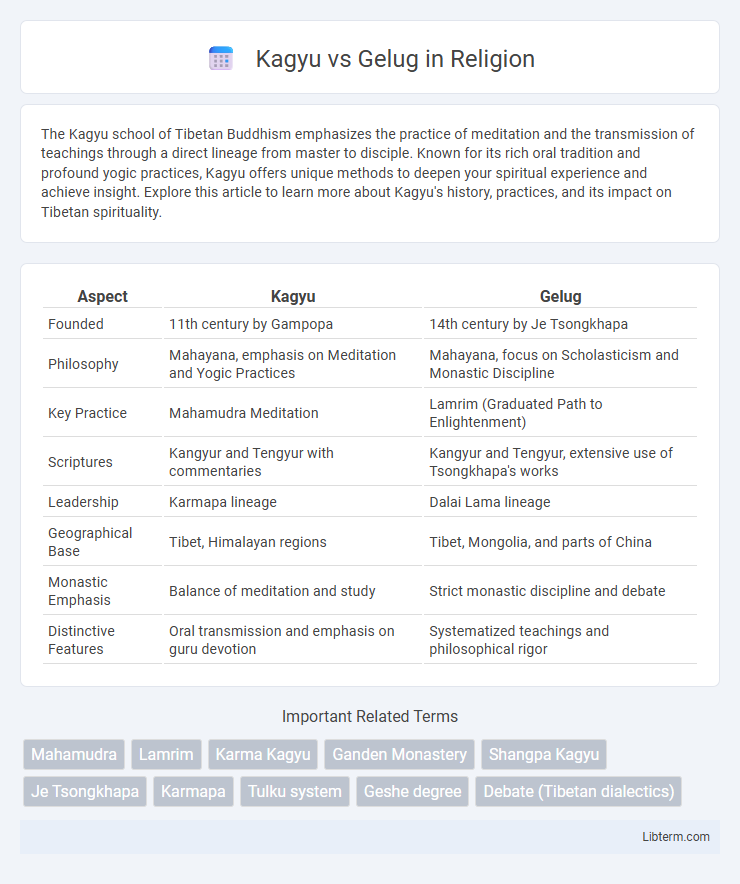The Kagyu school of Tibetan Buddhism emphasizes the practice of meditation and the transmission of teachings through a direct lineage from master to disciple. Known for its rich oral tradition and profound yogic practices, Kagyu offers unique methods to deepen your spiritual experience and achieve insight. Explore this article to learn more about Kagyu's history, practices, and its impact on Tibetan spirituality.
Table of Comparison
| Aspect | Kagyu | Gelug |
|---|---|---|
| Founded | 11th century by Gampopa | 14th century by Je Tsongkhapa |
| Philosophy | Mahayana, emphasis on Meditation and Yogic Practices | Mahayana, focus on Scholasticism and Monastic Discipline |
| Key Practice | Mahamudra Meditation | Lamrim (Graduated Path to Enlightenment) |
| Scriptures | Kangyur and Tengyur with commentaries | Kangyur and Tengyur, extensive use of Tsongkhapa's works |
| Leadership | Karmapa lineage | Dalai Lama lineage |
| Geographical Base | Tibet, Himalayan regions | Tibet, Mongolia, and parts of China |
| Monastic Emphasis | Balance of meditation and study | Strict monastic discipline and debate |
| Distinctive Features | Oral transmission and emphasis on guru devotion | Systematized teachings and philosophical rigor |
Overview of Kagyu and Gelug Schools
The Kagyu school of Tibetan Buddhism emphasizes meditation and the oral transmission of teachings, tracing its lineage to the Indian master Tilopa and the Tibetan yogi Marpa. The Gelug school, founded by Je Tsongkhapa in the 14th century, prioritizes monastic discipline, scholastic study, and philosophical rigor, with the Dalai Lama as its most prominent leader. Both schools contribute distinct practices and philosophies to Tibetan Buddhism, with Kagyu known for Mahamudra meditation and Gelug for its systematic approach to Buddhist philosophy.
Historical Origins and Development
The Kagyu school of Tibetan Buddhism originated in the 11th century with Marpa Lotsawa, who translated Indian Buddhist texts and emphasized meditation and oral transmission. The Gelug tradition was founded in the 14th century by Je Tsongkhapa, focusing on monastic discipline and scholarly study, leading to the establishment of prominent institutions like Ganden Monastery. Both schools played crucial roles in Tibet's religious history, with the Gelug lineage eventually becoming politically dominant through the institution of the Dalai Lama.
Founders and Key Figures
The Kagyu school was founded by Marpa Lotsawa, a Tibetan translator and disciple of Indian master Naropa, with Milarepa as its most famous yogi and Gampopa as a key consolidator of the tradition. The Gelug school, established by Je Tsongkhapa in the 14th century, is characterized by its emphasis on monastic discipline and scholasticism, with key figures including the Dalai Lamas, who have been spiritual and political leaders. Both schools have significantly shaped Tibetan Buddhism through their unique lineages and teachings.
Core Philosophical Teachings
Kagyu emphasizes direct experiential realization of mind's nature through Mahamudra meditation, highlighting spontaneous presence and non-dual awareness. Gelug centers on Tsongkhapa's scholastic approach, stressing rigorous study of Madhyamaka philosophy and the gradual path with systematic ethical discipline. Both traditions uphold Mahayana principles but diverge in methodology: Kagyu prioritizes meditative insight while Gelug focuses on philosophical clarity and analytical wisdom.
Meditation Practices and Techniques
Kagyu meditation practices emphasize Mahamudra, a direct experience of the mind's nature through calm-abiding and insight meditation. Gelug meditation techniques prioritize Lamrim, a structured path combining analytical meditation on Buddhist teachings and calm-abiding (shamatha) to develop concentration and wisdom. Both traditions employ visualization and mantra recitation, but Kagyu's approach is often more experiential, while Gelug maintains a systematic philosophical framework.
Monastic Organization and Structure
The Kagyu tradition emphasizes a flexible monastic organization centered around meditation centers led by experienced lamas, often organized into smaller retreat communities focusing on direct transmission of teachings. In contrast, the Gelug school maintains a highly structured and hierarchical monastic system, characterized by large monasteries such as Drepung and Sera with a formal educational curriculum culminating in the Geshe degree. Gelug monks follow strict disciplinary codes under the authority of the Dalai Lama and senior abbots, whereas Kagyu monasteries prioritize spiritual lineage and personal mentorship.
Approach to Tantra and Ritual
Kagyu tradition emphasizes direct experiential practice and Mahamudra meditation as central to tantra, valuing spontaneous realization and inner purity over elaborate rituals. Gelug school prioritizes strict adherence to tantric vows, scholarly study, and detailed ritual procedures, integrating tantra within a framework of disciplined monastic practice. The contrasting approaches reflect Kagyu's focus on yogic union and personal transformation versus Gelug's emphasis on structured ritualistic mastery and philosophical understanding.
Lineage Transmission and Leadership
Kagyu lineage transmission centers on the unbroken guru-disciple devotion, traced from Marpa Lotsawa through Milarepa to the Karmapas, emphasizing direct oral transmission and meditation practice guidance. Gelug's lineage transmission follows the structured scholastic tradition established by Je Tsongkhapa, combining rigorous monastic education with a hierarchy led by successive Dalai Lamas. Leadership in Kagyu is characterized by the recognition of incarnate lamas like the Karmapa, while Gelug maintains centralized authority through the Dalai Lama, embodying both spiritual and political leadership roles.
Influence on Tibetan Culture and Society
The Kagyu school of Tibetan Buddhism is renowned for its emphasis on meditation practices and oral transmission, significantly shaping Tibetan cultural rituals and art forms through its rich yogic traditions. The Gelug school, founded by Je Tsongkhapa, has exerted substantial influence on Tibetan society by promoting monastic discipline, scholastic excellence, and political leadership, notably through the Dalai Lama institution. Both schools have deeply impacted Tibetan identity, with Kagyu fostering spiritual devotion and Gelug integrating religious authority into governance and education.
Comparative Analysis: Kagyu vs Gelug
Kagyu and Gelug represent two prominent schools of Tibetan Buddhism, with Kagyu emphasizing experiential meditation practices and the guru-disciple relationship, while Gelug prioritizes monastic discipline and scholastic study. Kagyu lineage traces to Marpa and Milarepa, fostering a tradition centered on Mahamudra meditation, whereas Gelug, founded by Je Tsongkhapa, is known for its rigorous philosophical debate and systematic approach to tantric teachings. Both schools contribute distinct spiritual methodologies and institutional structures that shape Tibetan Buddhist practice and philosophy.
Kagyu Infographic

 libterm.com
libterm.com